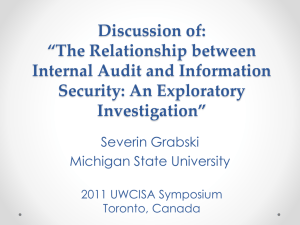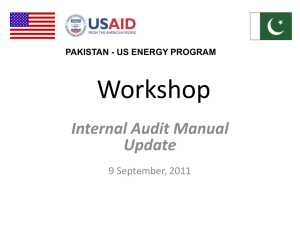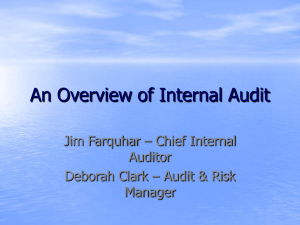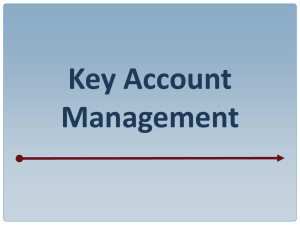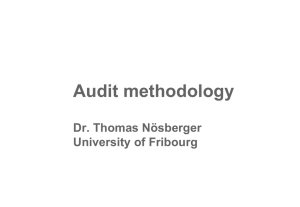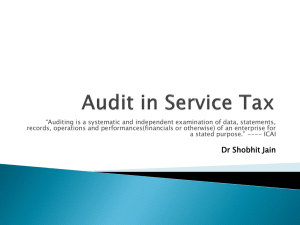Slides of Korea
advertisement
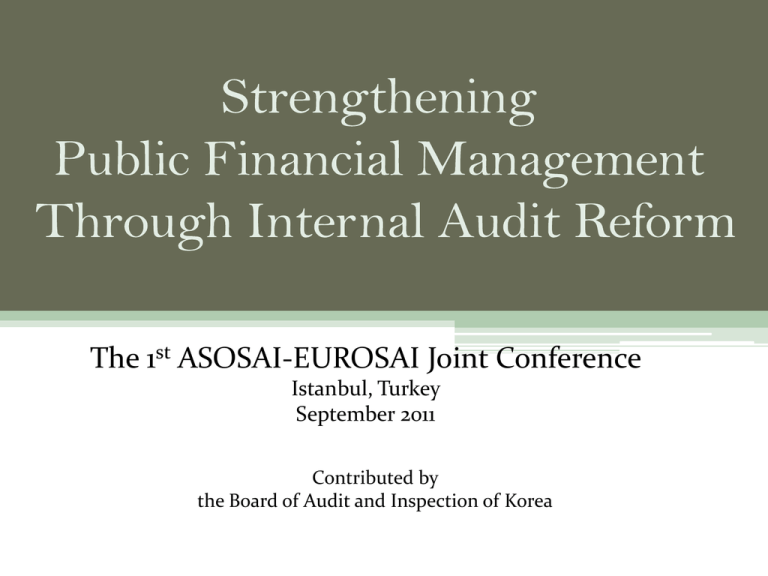
The 1st ASOSAI-EUROSAI Joint Conference Istanbul, Turkey September 2011 Contributed by the Board of Audit and Inspection of Korea 2 Overview 1. Introduction 2. Road to the enactment of the Public Sector Internal Audit Act 3. Key elements of the Public Sector Internal Audit Act 4. BAI’s role in establishing the internal audit system 5. Some early outcomes and challenges 3 1. Introduction • Objectives of Public Financial Management (PFM): ▫ Fiscal discipline ▫ Allocation of resources to priority needs ▫ Efficient/effective delivery of public services • Despite numerous attempts to achieve the objectives, PFM system has not succeeded due to the lack of effective: ▫ Control over the growth of expenditures ▫ Prevention of the waste of public money ▫ Response to the changing environment Public trust was jeopardized. 4 1. Introduction (cont.) • The BAI’s leadership in restoring public trust - The BAI, as the Supreme Audit Institution (SAI) of Korea, initiated the enactment of a basic law for internal audit units (IAUs), ‘Public Sector Internal Audit Act.’ • Essence of the Act: - Re-establishment of the roles and functions of IAUs as a way of improving PFM 4 5 2. Road to the enactment of the Public Sector Internal Audit Act • Korea’s Internal audit system in the past: Time 1962 Late 1980s Decisions of the Gov’t Drawbacks Introduced the internal audit Importance of financial management system. was not fully considered. • Decentralized the internal audit system. • Gave the heads of public organizations autonomy to decide on the matters of internal audit. • Internal audit function was carried out by a division of planning or legal affairs. • Auditors were appointed from among generalists within the organizations through job rotation. • Independence and professionalism could not be ensured. 5 6 2. Road to the Enactment of the Public Sector Internal Audit Act (cont.) • The BAI’s efforts to unravel the status-quo of the internal auditing system: 1. In 2003, the BAI opened up discussion on establishing an overarching law governing a whole set of rules on internal audit functions in the public sector. 2. The BAI confronted strong opposition from public entities that were concerned that the Act might infringe on their management authority on organization and personnel. 3. To head off criticism, the BAI advocated the necessity of the law at public policy hearings and symposia attended by the National Assembly and other stakeholders. 4. After 7 years, the BAI succeeded in enacting the Public Sector Internal Audit Act in 2010. 6 7 3. Key Elements of the Public Sector Internal Audit Act 1. Mandating the establishment of internal audit units: - Legal basis: an IAU should be established within each public organization. 2. Ensuring independence of internal auditing: - Independence in audit activities, organization, personnel, and budget. - Heads of IAU: recruited internally/externally (through an open competition) with a fixed term of office. 3. Strengthening professionalism of internal auditors: - Heads of IAU may call on external experts for special skills/experiences, if necessary. - Heads of public organizations: may give incentives and/or promotion to internal auditors. 7 8 3. Key Elements of the Public Sector Internal Audit Act (cont.) 4. Standardized and transparent audit process: - Audit standards/ code of conduct - Auditors’ right to access documents and ask the parties concerned to appear and answer. - Publication release was encouraged. 5. Cooperation between SAIs and internal auditors: - Establishment: a Joint Coordination Committee - Evaluation of IAUs on management, audit operation and audit performance. - Report of the evaluation to the National Assembly 9 4. BAI’ s Role in Establishing the Internal Audit System I. As a supervisor: - Conducts a comprehensive assessment on the performance of IAUs on a regular basis. II. As a promoter: - Promulgates the audit standards, guidelines and manuals; - Organizes training workshops/seminars for internal auditors; and - Serves as an internal audit clearing house for the IAUs. III. As a partner: - Communicates actively with the heads of IAU to seek cooperation for mutual trust (Joint Coordination Committee) 9 10 5. Some Early Outcomes and Challenges Outcomes achieved Challenges to address 1. Increased number of IAUs have been established within public 1. More internal audit results should entities; be disclosed in full text; 2. More IAU heads were recruited 2. Expanding the mandates of externally; internal auditing should be given 3. Cooperative relationship was an impetus (i.e. pre-audit); and expanded into new areas 3. Still, the heads of public - Internal audit standards organizations have a concern that - Joint Coordination Committee the establishment of an - Internal Audit Support Group; and independent IAU would 4. Internal auditing gained more undermine the autonomy of their attention from the public. (increased organizations. news coverage on internal auditing) 10 Thank you! The Board of Audit and Inspection of Korea

